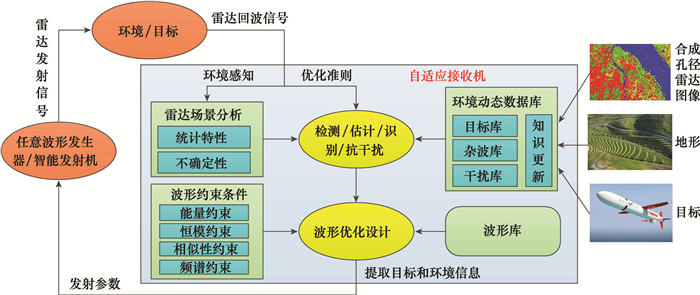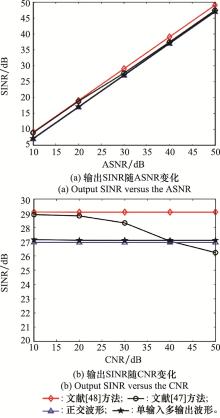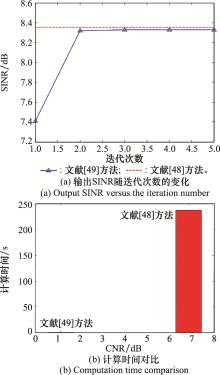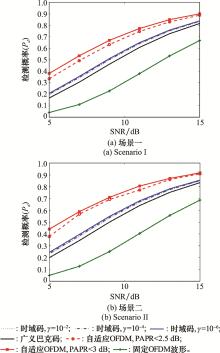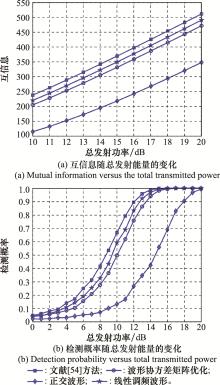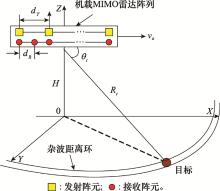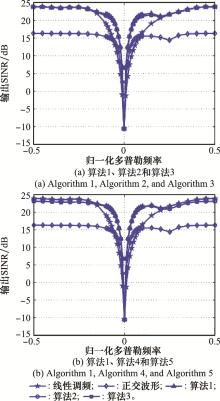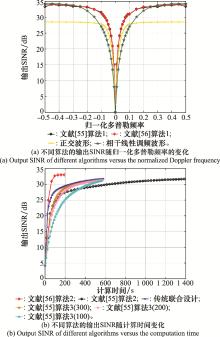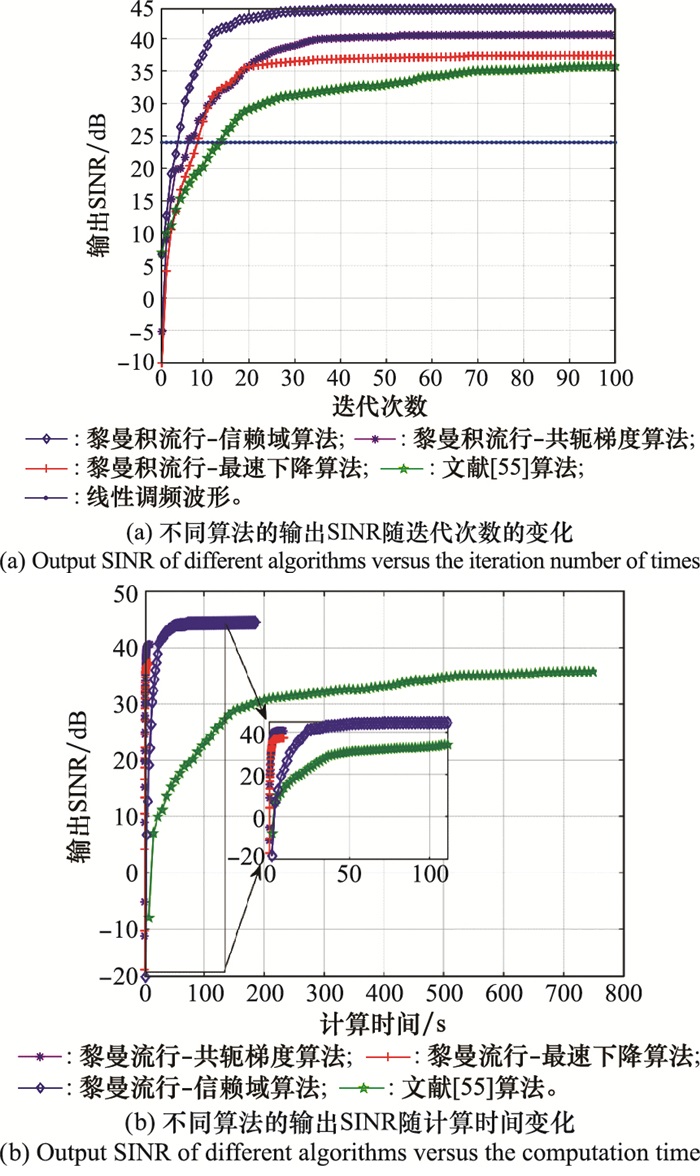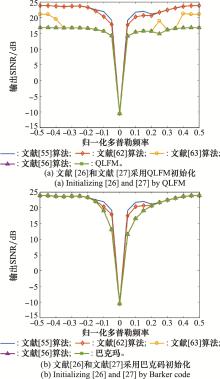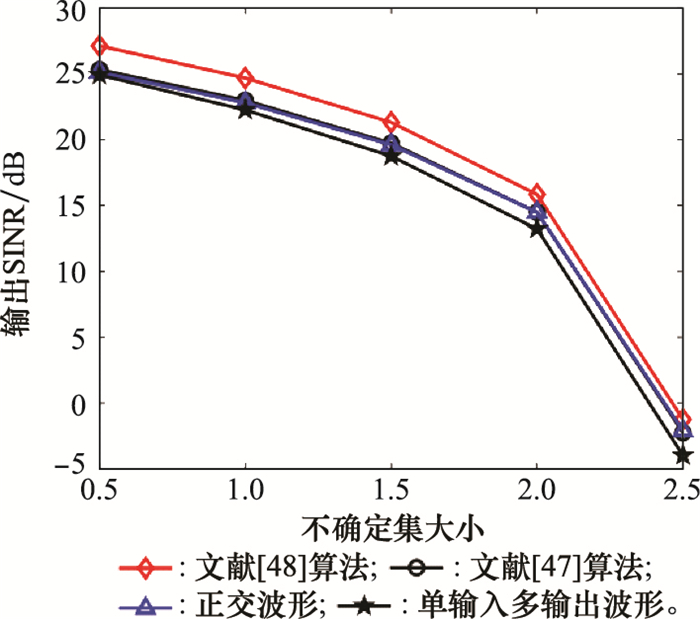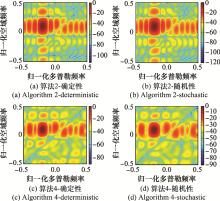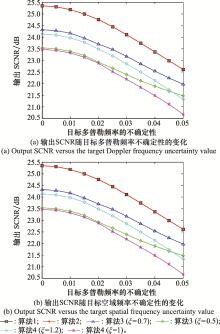Systems Engineering and Electronics ›› 2023, Vol. 45 ›› Issue (12): 3852-3865.doi: 10.12305/j.issn.1001-506X.2023.12.15
• Sensors and Signal Processing • Previous Articles
Overview of waveform design methods for new system airborne radar
Zhihui LI, Bo TANG, Qingsong ZHOU, Junpeng SHI, Jianyun ZHANG
- National University of Defense Technology, College of Electronic Engineering, Hefei 230037, China
-
Received:2021-09-06Online:2023-11-25Published:2023-12-05 -
Contact:Zhihui LI
CLC Number:
Cite this article
Zhihui LI, Bo TANG, Qingsong ZHOU, Junpeng SHI, Jianyun ZHANG. Overview of waveform design methods for new system airborne radar[J]. Systems Engineering and Electronics, 2023, 45(12): 3852-3865.
share this article
| 1 | 吴汉平. 机载雷达导论[M]. 北京: 电子工业出版社, 2005. |
| WU H P . Introduction to airborne radar[M]. Beijing: Electronic Industry Press, 2005. | |
| 2 | BRENNAN L E , REED I S . Theory of adaptive radar[J]. IEEE Trans.on Aerospace and Electronic Systems, 1973, 9 (2): 237- 252. |
| 3 | WARD J. Space-time adaptive processing for airborne radar[R]. London: IEE Colloquium on Space-Time Adaptive Processing, 1998. |
| 4 | 王永良, 彭应宁. 空时自适应信号处理[M]. 北京: 清华大学出版社, 2000. |
| WANG Y L , PENG Y N . Space-time adaptive processing[M]. Beijing: Tsinghua University Press, 2000. | |
| 5 | KLEMM R . Principles of space-time adaptive processing[M]. London: IET Press, 2006. |
| 6 | GUERCI J R . Space-time adaptive processing for radar[M]. Norwood, MA: Artech House, 2003. |
| 7 |
MELVIN W L . A STAP overview[J]. IEEE Aerospace and Electronic Systems Magazine, 2004, 19 (1): 19- 35.
doi: 10.1109/MAES.2004.1263229 |
| 8 | 阳召成, 黎湘, 王宏强. 基于空时功率谱稀疏性的空时自适应处理技术研究进展[J]. 电子学报, 2014, 42 (6): 1194- 1204. |
| YANG Z C , LI X , WANG H Q . An overview of space-time adaptive processing technology based on sparsity of space-time power spectrum[J]. Acta Electronica Sinica, 2014, 42 (6): 1194- 1204. | |
| 9 | 张良, 祝欢, 杨予昊, 等. 机载预警雷达技术及信号处理方法综述[J]. 电子与信息学报, 2016, 38 (12): 3298- 3306. |
| ZHANG L , ZHU H , YANG Y H , et al. Overview on airborne early warning radar technology and signal processing methods[J]. Journal of Electronics & Information Technology, 2016, 38 (12): 3298- 3306. | |
| 10 | 谢文冲, 段克清, 王永良. 机载雷达空时自适应处理技术研究综述[J]. 雷达学报, 2017, 6 (6): 575- 586. |
| XIE W C , DUAN K Q , WANG Y L . Space time adaptive processing technique for airborne radar: an overview of its development and prospects[J]. Journal of Radars, 2017, 6 (6): 575- 586. | |
| 11 | 王珽, 赵拥军, 胡涛. 机载MIMO雷达空时自适应处理技术研究进展[J]. 雷达学报, 2015, 4 (2): 136- 148. |
| WANG T , ZHAO Y J , HU T . Overview of space-time adaptive processing for airborne MIMO radar[J]. Journal of Radars, 2015, 4 (2): 136- 148. | |
| 12 | 段克清, 袁华东, 许红, 等. 稀疏恢复空时自适应处理技术研究综述[J]. 电子学报, 2019, 47 (3): 748- 756. |
| DUAN K Q , YUAN H D , XU H , et al. An overview of sparse recovery space-time adaptive processing technique[J]. Acta Electronica Sinica, 2019, 47 (3): 748- 756. | |
| 13 | 肖博, 霍凯, 刘永祥. 雷达通信一体化研究现状与发展趋势[J]. 电子与信息学报, 2019, 41 (3): 739- 750. |
| XIAO B , HUO K , LIU Y X . Development and prospect of radar and communication integration[J]. Journal of Electronics & Information Technology, 2019, 41 (3): 739- 750. | |
| 14 | 刘凡, 袁伟杰, 原进宏, 等. 雷达通信频谱共享及一体化[J]. 雷达学报, 2021, 10 (3): 467- 484. |
| LIU F , YUAN W J , YUAN J H , et al. Radar-communication spectrum sharing and integration: overview and prospect[J]. Journal of Radars, 2021, 10 (3): 467- 484. | |
| 15 |
HAYKIN S . Cognitive radar: a way of the future[J]. IEEE Trans.on Signal Processing Magazine, 2006, 23 (1): 30- 40.
doi: 10.1109/MSP.2006.1593335 |
| 16 |
GRECO M S , GINI F , STINCO P , et al. Cognitive radars: on the road to reality[J]. IEEE Trans.on Signal Processing Magazine, 2018, 35 (4): 112- 125.
doi: 10.1109/MSP.2018.2822847 |
| 17 |
GUERCI J R , BARANOSKI E J . Knowledge-aided adaptive radar at DARPA: an overview[J]. IEEE Trans.on Signal Processing Magazine, 2006, 23 (1): 41- 50.
doi: 10.1109/MSP.2006.1593336 |
| 18 | 崔国龙, 余显祥, 杨婧, 等. 认知雷达波形优化设计方法综述[J]. 雷达学报, 2019, 8 (5): 537- 557. |
| CUI G L , YU X X , YANG J , et al. An overview of waveform optimization methods for cognitive radar[J]. Journal of Radars, 2019, 8 (5): 537- 557. | |
| 19 | LI J , STOICA P . MIMO radar signal processing[M]. Hoboken, New Jersey: John Wiley & Sons, Inc, 2009. |
| 20 |
STOICA P , LI J . MIMO radar with colocated antennas[J]. IEEE Trans.on Signal Processing Magazine, 2007, 24 (5): 106- 114.
doi: 10.1109/MSP.2007.904812 |
| 21 |
HAIMOVICH A M , BLUM R S , CIMINI L J . MIMO radar with widely separated antennas[J]. IEEE Trans.on Signal Processing Magazine, 2008, 25 (1): 116- 129.
doi: 10.1109/MSP.2008.4408448 |
| 22 | RABIDEAU D J, PARKER P. Ubiquitous MIMO multifunction digital array radar[C]//Proc. of the 37th Asilomar Confe-rence on Signals, Systems and Computers, 2003: 1057-1064. |
| 23 | BLISS D W, FORSYTHE K W. Multiple-input multiple-output (MIMO) radar and imaging: degrees of freedom and resolution[C]//Proc. of the 37th Asilomar Conference Signals, Systems, Computers, 2003: 54-59. |
| 24 | MECCA V F, RAMAKRISHNAN D, KROLIK J L. MIMO radar space-time adaptive processing for multipath clutter mitigation[C]//Proc. of the IEEE 4th Workshop Sensor Array Multichannel Processing, 2006: 249-253. |
| 25 |
CHEN C Y , VAIDYANATHAN P P . MIMO radar space-time adaptive processing using prolate spheroidal wave functions[J]. IEEE Trans.on Signal Processing, 2008, 56 (2): 623- 634.
doi: 10.1109/TSP.2007.907917 |
| 26 |
XU L , LI J , STOICA P . Target detection and parameter estimation for MIMO radar systems[J]. IEEE Trans.on Aerospace and Electronic Systems, 2008, 44 (3): 927- 939.
doi: 10.1109/TAES.2008.4655353 |
| 27 | GODRICH H , HAIMOVICH A M , BLIM R S . Target localization accuracy gain in MIMO radar-based systems[J]. IEEE Trans.on Signal Processing, 2010, 56 (6): 2783- 2803. |
| 28 |
XU J W , LIAO G S , ZHU S Q , et al. Joint range and angle estimation using MIMO radar with frequency diverse array[J]. IEEE Trans.on Signal Processing, 2015, 63 (13): 3396- 3410.
doi: 10.1109/TSP.2015.2422680 |
| 29 |
XU J W , LIAO G S , ZHU S Q , et al. Deceptive jamming suppression with frequency diverse MIMO radar[J]. Signal Processing, 2015, 113, 9- 17.
doi: 10.1016/j.sigpro.2015.01.014 |
| 30 |
LAN L , XU J W , LIAO G S , et al. Suppression of mainbeam deceptive jammer with FDA-MIMO radar[J]. IEEE Trans.on Vehicular Technology, 2020, 69 (10): 11584- 11598.
doi: 10.1109/TVT.2020.3014689 |
| 31 | 时晨光, 董璟, 周建江, 等. 飞行器射频隐身技术研究综述[J]. 系统工程与电子技术, 2021, 43 (6): 1452- 1467. |
| SHI C G , DONG J , ZHOU J J , et al. Overview of aircraft radio frequency stealth technology[J]. Systems Engineering and Electronics, 2021, 43 (6): 1452- 1467. | |
| 32 | WICKS M , MOKOLE E , BLUNT S , et al. Principles of waveform diversity and design[M]. Raleigh NC: SciTech Publishing, 2010. |
| 33 | HAYKIN S, XUE Y, DAVIDSON T N. Optimal waveform design for cognitive radar[C]//Proc. of the 42nd Asilomar Conference on Signals, Systems and Computers, 2008: 3-7. |
| 34 |
STOICA P , LI J , XIE Y . On probing signal design for MIMO radar[J]. IEEE Trans.on Signal Processing, 2007, 55 (8): 4151- 4161.
doi: 10.1109/TSP.2007.894398 |
| 35 | GINI F , DE MAIO A , PATTON L K . Waveform design and diversity for advanced radar systems[M]. London: IET Press, 2012. |
| 36 |
STOICA P , HE H , LI J . Optimization of the receive filter and transmit sequence for active sensing[J]. IEEE Trans.on Signal Processing, 2012, 60 (4): 1730- 1740.
doi: 10.1109/TSP.2011.2179652 |
| 37 |
CUI G L , LI H B , RANGASWAMY M . MIMO radar waveform design with constant modulus and similarity constraints[J]. IEEE Trans.on Signal Processing, 2014, 62 (2): 343- 353.
doi: 10.1109/TSP.2013.2288086 |
| 38 | KARBASI S M , AUBRY A , CAROTENUTO V , et al. Know-ledge-based design of space-time transmit code and receive filter for a multiple-input-multiple-output radar in signal-dependent interference[J]. IET Radar, Sonar & Navigation, 2015, 9 (8): 1124- 1135. |
| 39 |
AUBRY A , DE MAIO A , NAGHSH M M , et al. Optimizing radar waveform and Doppler filter bank via generalized fractional programming[J]. IEEE Trans.on Journal of Selected Topics in Signal Processing, 2015, 9 (8): 1387- 1399.
doi: 10.1109/JSTSP.2015.2469259 |
| 40 |
CHENG Z Y , HE Z S , ZAHNG S M , et al. Constant modulus waveform design for MIMO radar transmit beampattern[J]. IEEE Trans.on Signal Processing, 2017, 65 (18): 4912- 4923.
doi: 10.1109/TSP.2017.2718976 |
| 41 |
CUI G L , YU X X , CAROTENUTO V , et al. Space-time transmit code and receive filter design for colocated MIMO radar[J]. IEEE Trans.on Signal Processing, 2017, 65 (5): 1116- 1129.
doi: 10.1109/TSP.2016.2633242 |
| 42 |
CHENG Z Y , HE Z S , LIAO B , et al. CMIMO radar waveform design with PAPR and similarity constraints[J]. IEEE Trans.on Signal Processing, 2018, 66 (4): 968- 981.
doi: 10.1109/TSP.2017.2780052 |
| 43 |
CUI G L , FU Y , YU X X , et al. Robust transmitter-receiver design for extended target in signal-dependent interference[J]. Signal Processing, 2018, 147, 60- 67.
doi: 10.1016/j.sigpro.2018.01.007 |
| 44 |
FAN W , LIANG J L , YU G Y , et al. MIMO radar waveform design for quasi-equiripple transmit beampattern synthesis via weighted lp minimization[J]. IEEE Trans.on Signal Processing, 2019, 67 (13): 3397- 3411.
doi: 10.1109/TSP.2019.2917871 |
| 45 |
YU X X , CUI G L , YANG J , et al. MIMO radar transmit-receive design for moving target detection in signal-dependent clutter[J]. IEEE Trans.on Vehicular Technology, 2020, 69 (1): 522- 536.
doi: 10.1109/TVT.2019.2951399 |
| 46 |
DE MAIO A , NICOLA S D , HUANG Y W , et al. Code design for radar STAP via optimization theory[J]. IEEE Trans.on Signal Processing, 2010, 58 (2): 679- 694.
doi: 10.1109/TSP.2009.2032993 |
| 47 |
WANG H Y , LIAO G S , LI J , et al. Waveform optimization for MIMO-STAP to improve the detection performance[J]. Signal Processing, 2011, 91, 2690- 2696.
doi: 10.1016/j.sigpro.2011.06.005 |
| 48 |
TANG B , LI J , ZHANG Y , et al. Design of MIMO radar waveform covariance matrix for clutter and jamming suppression based on space-time adaptive processing[J]. Signal Processing, 2016, 121, 60- 69.
doi: 10.1016/j.sigpro.2015.10.033 |
| 49 | TANG B, ZHANG Y, TANG J. Computationally efficient waveform optimization for MIMO radar space time adaptive processing[C]//Proc. of the CIE International Conference on Radar, 2016. |
| 50 |
SEN S . PAPR-constrained pareto-optimal waveform design for OFDM-STAP radar[J]. IEEE Trans.on Geoscience and Remote Sensing, 2014, 52 (6): 3658- 3669.
doi: 10.1109/TGRS.2013.2274593 |
| 51 |
WANG H Y . Multi-input multi-output orthogonal frequency division multiplexing radar waveform design for improving the detection performance of space-time adaptive processing[J]. Journal of Applied Remote Sensing, 2017, 11 (2): 025013.
doi: 10.1117/1.JRS.11.025013 |
| 52 | 施君南, 纠博, 刘宏伟, 等. 一种基于先验信息的机载MIMO雷达发射方向图设计方法[J]. 电子与信息学报, 2015, 37 (5): 1038- 1043. |
| SHI J N , JIU B , LIU H W , et al. A beampattern design method for airborne MIMO radar based on prior information[J]. Journal of Electronics & Information Technology, 2015, 37 (5): 1038- 1043. | |
| 53 |
SHI J N , JIU B , LIU H W , et al. Transmit design for airborne MIMO radar based on prior information[J]. Signal Processing, 2016, 128, 521- 530.
doi: 10.1016/j.sigpro.2016.05.003 |
| 54 |
SUN G H , HE Z S , TONG J , et al. Mutual information-based waveform design for MIMO radar space-time adaptive processing[J]. IEEE Trans.on Geoscience and Remote Sensing, 2021, 59 (4): 2909- 2921.
doi: 10.1109/TGRS.2020.3008320 |
| 55 |
TANG B , TANG J . Joint design of transmit waveforms and receive filters for MIMO radar space-time adaptive processing[J]. IEEE Trans.on Signal Processing, 2016, 64 (18): 4707- 4722.
doi: 10.1109/TSP.2016.2569431 |
| 56 |
SHI S N , HE Z S , WANG Z Y . Joint design of transmit waveforms and receive filter for MIMO-STAP airborne radar[J]. Circuits, Systems, and Signal Processing, 2020, 39, 1489- 1508.
doi: 10.1007/s00034-019-01215-w |
| 57 |
LI J , LIAO G S , HUANG Y , et al. Manifold optimization for joint design of MIMO-STAP radars[J]. IEEE Trans.on Signal Processing Letters, 2020, 27, 1969- 1973.
doi: 10.1109/LSP.2020.3022239 |
| 58 |
LI J , LIAO G S , HUANG Y , et al. Riemannian geometric optimization methods for joint design of transmit sequence and receive filter on MIMO radar[J]. IEEE Trans.on Signal Processing, 2020, 68, 5602- 5616.
doi: 10.1109/TSP.2020.3022821 |
| 59 |
SETLUR P , RANGASWAMY M . Waveform design for radar STAP in signal dependent interference[J]. IEEE Trans.on Signal Processing, 2016, 64 (1): 19- 34.
doi: 10.1109/TSP.2015.2451114 |
| 60 |
O'ROURKE S M , SETLUR P , RANGASWAMY M , et al. Relaxed biquadratic optimization for joint filter-signal design in signal-dependent STAP[J]. IEEE Trans.on Signal Processing, 2018, 66 (5): 1300- 1315.
doi: 10.1109/TSP.2017.2775592 |
| 61 |
O'ROURKE S M , SETLUR P , RANGASWAMY M , et al. Quadratic semidefinite programming for waveform-constrained joint filter-signal design in STAP[J]. IEEE Trans.on Signal Processing, 2020, 68, 1744- 1759.
doi: 10.1109/TSP.2020.2977271 |
| 62 |
TANG B , TUCH J , STOICA P . Polyphase waveform design for MIMO radar space time adaptive processing[J]. IEEE Trans.on Signal Processing, 2020, 68, 2143- 2154.
doi: 10.1109/TSP.2020.2983833 |
| 63 |
YU X X , CUI G L , KONG L J , et al. Constrained waveform design for colocated MIMO radar with uncertain steering matrices[J]. IEEE Trans.on Aerospace and Electronics Systems, 2019, 55 (1): 356- 370.
doi: 10.1109/TAES.2018.2852200 |
| 64 | 童日武, 张剑云, 周青松. 峰均比约束下机载MIMO雷达频谱共存波形设计[J]. 空军工程大学学报(自然科学版), 2020, 21 (1): 44- 51. |
| TONG R W , ZHANG J Y , ZHOU Q S . Airborne MIMO radar waveform design for spectral coexistence with PAR constraint[J]. Journal of Air Force Engineering University (Natural Science Edition), 2020, 21 (1): 44- 51. | |
| 65 | WANG H Y , LIAO G S , LI J , et al. Robust waveform design for MIMO-STAP to improve the worst-case detection performance[J]. EURASIP Journal on Advances in Signal Processing, 2013, 1 (52): 7781387. |
| 66 |
WANG H Y , CHENG Q , PEI B N . Robust MIMO radar waveform design to improve the worst-case detection perfor-mance of STAP[J]. IEICE Trans.on Communications, 2018, E101-B (5): 1175- 1182.
doi: 10.1587/transcom.2017EBP3092 |
| 67 | WANG H Y . Robust waveform design for MIMO-OFDM based STAP in the presence of target uncertainty[J]. IET Radar, Sonar & Navigation, 2018, 12, 1021- 1027. |
| 68 | WANG X, WANG H Y, PEI B N. Robust waveform design for MIMO-OFDM-STAP with imperfect clutter prior know-ledge[C]//Proc. of the International Conference on Wireless Communications, Signal Processing and Networking (WiSPNET), 2016. DOI: 10.1109/WiSPNET.2016.7566462. |
| 69 | 刘玉春, 王洪雁. 提升空时自适应检测性能的多输入多输出雷达稳健波形设计[J]. 西安交通大学学报, 2018, 52 (8): 124- 131. |
| LIU Y C , WANG H Y . A robust waveform design of MIMO radar for improving detection performance of space-time adaptive processing[J]. Journal of Xi'an Jiaotong University, 2018, 52 (8): 124- 131. | |
| 70 | 姚遥, 周吉生, 李琼, 等. 非确知先验信息条件下MIMO雷达波形设计[J]. 火力与指挥控制, 2020, 45 (12): 57- 63. |
| YAO Y , ZHOU J S , LI Q , et al. MIMO radar waveform design with imperfect prior information[J]. Fire Control & Command Control, 2020, 45 (12): 57- 63. | |
| 71 | WANG Y X , LI W , SUN Q L , et al. Robust joint design of transmit waveform and receive filter for MIMO radar space-time adaptive processing with signal-dependent interferences[J]. IET Radar, Sonar & Navigation, 2017, 11 (8): 1321- 1332. |
| 72 | 童日武, 张剑云, 周青松. 机载MIMO雷达发射波形和接收滤波器组联合稳健设计方法[J]. 探测与控制学报, 2020, 42 (3): 35- 43. |
| TONG R W , ZHANG J Y , ZHOU Q S . Joint robust design method of transmit waveform and receive filter bank for airborne MIMO radar[J]. Journal of detection & control, 2020, 42 (3): 35- 43. | |
| 73 | ZHOU Q S , LI Z H , SHI J P , et al. Robust cognitive transmit waveform and receive filter for airborne MIMO radar in signal-dependent clutter environment[J]. Digital Signal Processing, 2020, 101, 102709. |
| 74 | 王洪雁, 乔惠娇, 裴炳南. MIMO雷达空时编码和接收权联合稳健设计[J]. 西安电子科技大学学报, 2019, 46 (2): 69- 77. |
| WANG H Y , QIAO H J , PEI B N . Joint robust design of space-time code and receive filter for multiple-input multiple-output radar[J]. Journal of Xidian University, 2019, 46 (2): 69- 77. | |
| 75 | XU J W , ZHU S Q , LIAO G S . Range ambiguous clutter suppression for airborne FDA-STAP radar[J]. IEEE Trans.on Journal of Selected Topics in Signal Processing, 2015, 9 (8): 1620- 1631. |
| 76 | XU J W , LIAO G S , SO H C . Space-time adaptive processing with vertical frequency diverse array for range-ambiguous clutter suppression[J]. IEEE Trans.on Geoscience and Remote Sensing, 2016, 54 (9): 5352- 5364. |
| 77 | XU J W , LIAO G S , ZHANG Y H , et al. An adaptive range-angle-Doppler processing approach for FDA-MIMO radar using three-dimensional localization[J]. IEEE Trans.on Journal of Selected Topics in Signal Processing, 2017, 11 (2): 309- 320. |
| 78 | WANG Y Z , ZHU S Q . Range ambiguous clutter suppression for FDA-MIMO forward looking airborne radar based on main lobe correction[J]. IEEE Trans.on Vehicular Technology, 2021, 70 (3): 2032- 2046. |
| 79 | HE X P , LIAO G S , ZHU S Q , et al. An adaptive coding-angle-Doppler clutter suppression approach with extended azimuth phase coding array[J]. Signal Processing, 2020, 169, 107377. |
| 80 | XU J W , ZHANG Y H , LIAO G S , et al. Resolving range ambiguity via multiple-input multiple-output radar with element-pulse coding[J]. IEEE Trans.on Signal Processing, 2020, 68, 2770- 2783. |
| 81 | 兰岚, 许京伟, 朱圣棋, 等. 波形分集阵列雷达抗干扰进展[J]. 系统工程与电子技术, 2021, 43 (6): 1438- 1451. |
| LAN L , XU J W , ZHU S Q , et al. Advances in anti-jamming using waveform diverse array radar[J]. Systems Engineering and Electronics, 2021, 43 (6): 1438- 1451. | |
| 82 | XIE L , HE Z S , TONG J , et al. Transmitter polarization optimization for space-time adaptive processing with diversely pola-rized antenna array[J]. Signal Processing, 2020, 169, 107401. |
| 83 | AUBRY A , DE MAIO A , PIEZZO M , et al. Radar waveform design in a spectrally crowded environment via nonconvex quadratic optimization[J]. IEEE Trans.on Aerospace and Electronic Systems, 2014, 50 (2): 1138- 1152. |
| 84 | HASSANIEN A , AMIN M G , ABOUTANIOS E , et al. Dual-function radar communication systems[J]. IEEE Trans.on Signal Processing Magazine, 2019, 36 (5): 115- 126. |
| 85 | CHENG Z Y , LIAO B , HE Z S , et al. Spectrally compatible waveform design for MIMO radar in the presence of multiple targets[J]. IEEE Trans.on Signal Processing, 2018, 66 (13): 3543- 3555. |
| 86 | QIAN J H , LOPS M , ZHENG L , et al. Joint system design for coexistence of MIMO radar and MIMO communication[J]. IEEE Trans.on Signal Processing, 2018, 66 (13): 3504- 3519. |
| 87 | RIHAN M , HUANG L . Optimum co-design of spectrum sharing between MIMO radar and MIMO communication systems: an interference alignment approach[J]. IEEE Trans.on Vehicular Technology, 2018, 67 (12): 11667- 11680. |
| 88 | TANG B , LI J . Spectrally constrained MIMO radar waveform design based on mutual information[J]. IEEE Trans.on Signal Processing, 2019, 67 (3): 821- 834. |
| 89 | YANG Z C , LI X , WNAG H Q , et al. On clutter sparsity analysis in space-time adaptive processing airborne radar[J]. IEEE Trans.on Geoscience and Remote Sensing Letters, 2013, 10 (5): 1214- 1218. |
| 90 | YANG Z C , LI X , WNAG H Q , et al. Adaptive clutter suppression based on iterative adaptive approach for airborne radar[J]. Signal Processing, 2013, 93 (12): 3567- 3577. |
| 91 | WNAG Z T , XIE W C , DUAN K Q , et al. Clutter suppression algorithm based on fast converging sparse Bayesian learning for airborne radar[J]. Signal Processing, 2017, 130, 159- 168. |
| 92 | LI Z H , ZHANG Y S , HE X Y , et al. Low complexity off-grid STAP algorithm based on local search clutter subspace estimation[J]. IEEE Trans.on Geoscience and Remote Sensing Letters, 2018, 15 (12): 1862- 1866. |
| 93 | HU H , SOLTANLIAN M , STOICA P , et al. Locating the few: sparsity-aware waveform design for active radar[J]. IEEE Trans.on Signal Processing, 2017, 65, 651- 662. |
| [1] | Qian CHENG, Jia LI, Juan DU. Ship target detection algorithm of optical remote sensing image based on YOLOv5 [J]. Systems Engineering and Electronics, 2023, 45(5): 1270-1276. |
| [2] | Jinyang HE, Ziyang CHENG, Zhanlei LI, Zishu HE, Minghui SHA. Low Doppler sensitive waveform design method against interrupted sampling repeater jamming [J]. Systems Engineering and Electronics, 2023, 45(5): 1333-1341. |
| [3] | Jingjing ZHU, Shengqi ZHU, Guisheng LIAO, Jingwei XU, Lan LAN, Cao ZENG. Joint target detection based on phased array and frequency diverse array dual-mode radar [J]. Systems Engineering and Electronics, 2023, 45(5): 1342-1350. |
| [4] | Yuchao YANG, Ming FANG, Chenfan ZHAO, Gang FANG. Long-time coherent integration algorithm for high-speed maneuvering targets [J]. Systems Engineering and Electronics, 2023, 45(5): 1359-1370. |
| [5] | Dongdong ZHANG, Chunping WANG, Qiang FU. Ship target detection in SAR image based on feature-enhanced network [J]. Systems Engineering and Electronics, 2023, 45(4): 1032-1039. |
| [6] | Ziqiang MENG, Wei GAO, Xiaoming LI. Two-dimensional ground stationary target detection algorithm for airborne radar [J]. Systems Engineering and Electronics, 2023, 45(4): 1040-1048. |
| [7] | An'an WANG, Wenchong XIE, Wei CHEN, Yuanyi XIONG, Yongliang WANG. Clutter and main-lobe suppression jamming suppression method for bistatic airborne radar [J]. Systems Engineering and Electronics, 2023, 45(3): 699-707. |
| [8] | Yunpu ZHANG, Ganlin SHAN, Yan HUANG, Qiang FU. Multiple mobile sensors scheduling method for ground target detection and tracking considering blind zone [J]. Systems Engineering and Electronics, 2023, 45(2): 453-464. |
| [9] | Zhuzhen HE, Min LI, Yao GOU, Aitao YANG. Ship target detection method for synthetic aperture radar images based on improved YOLOv5 [J]. Systems Engineering and Electronics, 2023, 45(12): 3743-3753. |
| [10] | Jianxiong ZHOU, Yongfeng ZHU, Ji CHEN, Hongming WU, Kun WU, Yongjie ZHANG. HRRP detection and recognition of radar targets based on assistant SAR images [J]. Systems Engineering and Electronics, 2023, 45(11): 3428-3436. |
| [11] | Chao HUANG, Zhongrui HUANG, Qingsong ZHOU, Jianyun ZHANG. Transmit waveform design for MIMO radar communication system based on optimal constellation [J]. Systems Engineering and Electronics, 2023, 45(10): 3016-3023. |
| [12] | Yu XIAO, Zhenghong DENG, Zhan ZHANG. Waveform design based on two-stage mutual information for multi-target detection [J]. Systems Engineering and Electronics, 2022, 44(9): 2736-2742. |
| [13] | Yuanyi XIONG, Wenchong XIE. Adaptive iterative monopulse estimation method based on space-time constraint [J]. Systems Engineering and Electronics, 2022, 44(8): 2506-2514. |
| [14] | Jinling LIAO, Guisheng LIAO, Jingwei XU, Lan LAN. Analysis on the performance of resolving range ambiguity based on a coding scheme design for EPC-MIMO [J]. Systems Engineering and Electronics, 2022, 44(7): 2166-2174. |
| [15] | Xiang LIU, Tianyao HUANG, Yimin LIU. Distributed target detection for frequency agile radars [J]. Systems Engineering and Electronics, 2022, 44(6): 1833-1838. |
| Viewed | ||||||
|
Full text |
|
|||||
|
Abstract |
|
|||||

